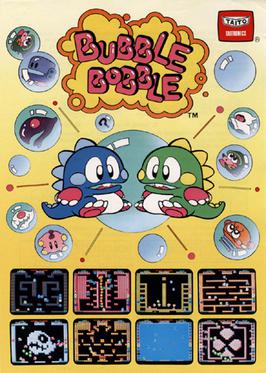
Bubble Bobble is a 1986 platform game developed and published by Taito for arcades. It was distributed in the United States by Romstar, and in Europe by Electrocoin. Players control Bub and Bob, two dragons that set out to save their girlfriends from a world known as the Cave of Monsters. In each level, Bub and Bob must defeat each enemy present by trapping them in bubbles and popping, who turn into bonus items when they hit the ground. There are 100 levels total, each becoming progressively more difficult.

Arkanoid is a 1986 block breaker arcade game developed and published by Taito. In North America, it was published by Romstar. Controlling a paddle-like craft known as the Vaus, the player is tasked with clearing a formation of colorful blocks by deflecting a ball towards it without letting the ball leave the bottom edge of the playfield. Some blocks contain power-ups that have various effects, such as increasing the length of the Vaus, creating several additional balls, or equipping the Vaus with cannons. Other blocks may be indestructible or require multiple hits to break.

The NewZealand Story is a platform game developed and released in arcades by Taito in 1988. The concept and setting were inspired by a holiday trip in New Zealand by one of the Taito programmers. The player controls Tiki (ティキ), a kiwi who must save his girlfriend Phee Phee (ピューピュー) and several of his other kiwi chick friends who have been kidnapped by a large blue leopard seal. While avoiding enemies, the player has to navigate a scrolling maze-like level, at the end of which they release one of Tiki's kiwi chick friends trapped in a cage. In 2007, the arcade game received a remake for the Nintendo DS under the title New Zealand Story Revolution.

Rainbow Islands: The Story of Bubble Bobble 2 (レインボーアイランド) is a 1987 arcade video game developed and published by Taito, with the arcade version licensed to Romstar for North American manufacturing and distribution. The game is the sequel to Bubble Bobble from the previous year, and it is the second of four arcade games in the series. The game was ported to home computers and home video game consoles.
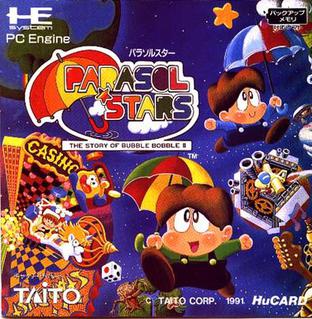
Parasol Stars: The Story of Bubble Bobble III (パラソルスター) is a video game by Taito released in 1991. It is a sequel to Rainbow Islands and the third game in the Bubble Bobble series.

Bubble Symphony, also known as Bubble Bobble II, is an arcade video game in the Bubble Bobble series developed by Taito in 1994. While being a new Bubble Bobble for a new generation, it takes place after Parasol Stars.

Don Doko Don is a platform arcade game developed and released by Taito in 1989. In the game, the player(s) control two lumberjacks, Bob and Jim, with the objective being to clear the screen of all the enemies. Bob and Jim use their mallets to stun the enemies, pick up the enemies, then throw them at a wall, or other enemies to kill them off, resulting in bonus points. Bonus items also appear during stages that will have varying effects on the players.

The Fairyland Story is a platform arcade video game developed and published by Taito in 1985. In the game, the player controls the witch Ptolemy, with the objective being to clear the screen of all enemies. Ptolemy can use her wand to turn the enemies into large cakes, which she can then push off of platforms onto other enemies, which will squash them and award bonus points. Various items that increase Ptolemy's projectile radius, as well as kill multiple enemies at the same time, will also appear throughout the stages.

Puzzle Bobble 2 is a tile-matching video game by Taito. The first sequel to Puzzle Bobble, it is also known in Europe and North America as Bust-A-Move Again for arcades and Bust-A-Move 2: Arcade Edition for home consoles. Released into the arcades in 1995, home conversions followed for the PlayStation, Sega Saturn, Nintendo 64, and Windows platforms. The game was included in Taito Legends 2, but the US arcade version was included on the US PS2 version instead. Further ports for the Nintendo Switch, PlayStation 4, and Xbox One were released by City Connection alongside Puzzle Bobble 3 in February 2023.
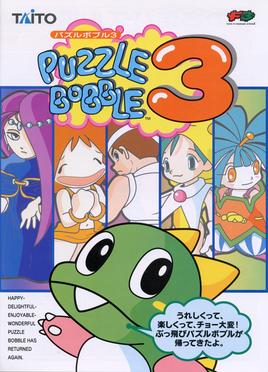
Puzzle Bobble 3 is an action puzzle video game developed by Taito. The second sequel to Puzzle Bobble, it was released for arcades in September 1996 and later ported to the Sega Saturn, PlayStation, Game Boy, Nintendo 64 and Microsoft Windows. Like its predecessors, the player is tasked with shooting balls at groups of balls, creating groups of three or more, which are then removed from play. Further ports for the Nintendo Switch, PlayStation 4 and Xbox One were released in February 2023 by City Connection alongside Puzzle Bobble 2.
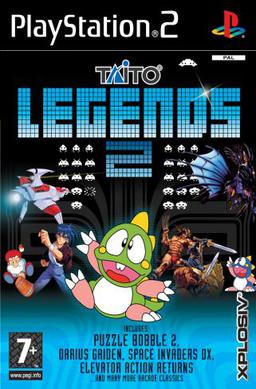
Taito Legends 2 a compilation of Taito arcade video games and the follow-up to Taito Legends. It was published for Xbox, PlayStation 2, and Microsoft Windows. As with the former collection, it is derived from the Japan exclusive Taito Memories series.
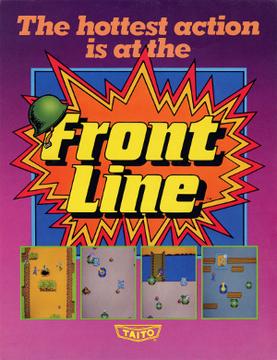
Front Line is a military-themed run and gun video game released by Taito for arcades in November 1982. It was one of the first overhead run and gun games, a precursor to many similarly-themed games of the mid-to-late 1980s. Front Line is controlled with a joystick, a single button, and a rotary dial that can be pushed in like a button. The single button is used to throw grenades and to enter and exit tanks, while the rotary dial aims and fires the player's gun.

Ben Bero Beh is a platform arcade game released by Taito in 1984. The player guides Dami-chan, a superhero, through an apartment complex which is on fire. Armed with a fire extinguisher, Dami-chan must make his way down the levels avoiding gas explosions, crumbling floors, damaged lighting fixtures, and various enemies that pop out of the doors. The goal is to extinguish the fire and rescue Dami-chan's girlfriend, Nao-chan.
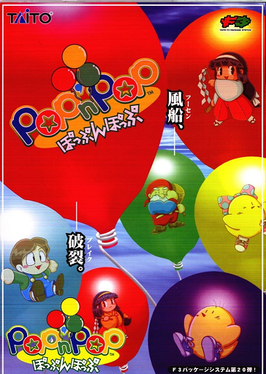
Pop'n Pop is a puzzle video game released in arcades by Taito in February 1998. It features characters from Taito games Rainbow Islands, Kiki Kaikai, Don Doko Don, and The NewZealand Story,
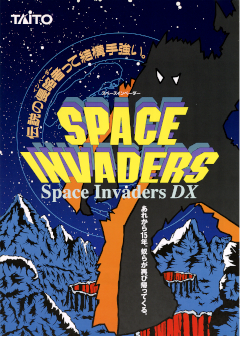
Space Invaders DX is a 1993 fixed shooter arcade game developed and published in Japan by Taito. It has been re-released for several consoles since, including the Super Nintendo Entertainment System, PC Engine CD, and Sega Saturn — several of these conversions use the name Space Invaders: The Original Game. The player assumes control of a laser base that must fend off waves of incoming enemies, who march down in formation towards the bottom of the screen. It is the fifth entry in the long-running Space Invaders series. DX contains four variations of the original Space Invaders, in addition to a multiplayer mode and a "Parody Mode" that replaces the characters with those from other Taito franchises. Home ports of DX received mixed reviews for their high price point and general lack of content.

M2 Co., Ltd. is a Japanese video game developer and publisher, best known for handling emulation of re-released games, such as some Sega Ages titles, Virtual Console titles for Nintendo systems, the 3D Classics series for the Nintendo 3DS and their ShotTriggers range of classic STG games. M2 has also created entirely new titles such as WiiWare games for Konami under the ReBirth moniker and more recently a new GG Aleste game. In addition, M2 currently holds the rights of Aleste series and all NEC Avenue and NEC Interchannel games on TurboGrafx-16 and variants, previously owned by Lightweight.
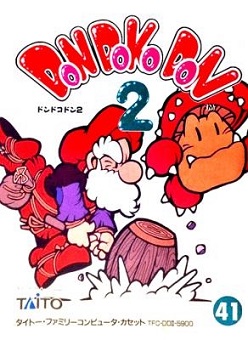
Don Doko Don 2 (ドンドコドン2) is a side-scrolling 2D platform game, developed by Natsume and published by Taito, which was only released in Japan in 1992. It is the sequel to the arcade game Don Doko Don.
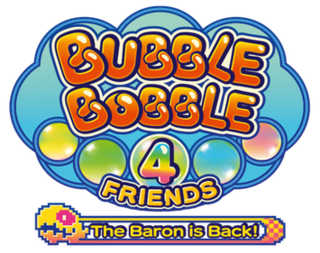
Bubble Bobble 4 Friends is a platform arcade game developed and published by Taito in Japan, and published by ININ games worldwide. The game is part of the Bubble Bobble arcade series. The game's reception had been mixed when it was first released on the Nintendo Switch, but the PlayStation 4 version was better received one year later.

Touhou Spell Bubble is a rhythm based competitive arcade puzzle game developed in 2020 by Taito as an officially licensed spin-off in the Touhou Project series. The gameplay is similar to that of the Puzzle Bobble series, which Taito also developed. The company has referred to the game as "Puzzle Bobble meets Touhou Project," implying that they consider it to also be a spinoff of both series.




















